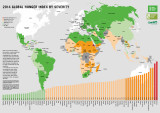Biofuels and food security
Biofuel demand is increasing because of a combination of growing energy needs; rising oil costs; the pursuit of clean, renewable sources of energy; and the desire to boost farm incomes in developed countries. In turn, the need for crops-such as maize and sugarcane-to be used as feedstocks for biofuels has increased dramatically. That demand has had a significant and increasing impact on global food systems. The effects of growing biofuel demand are interwoven with tightening grain markets, which reflect demographic shifts and improved diets.












